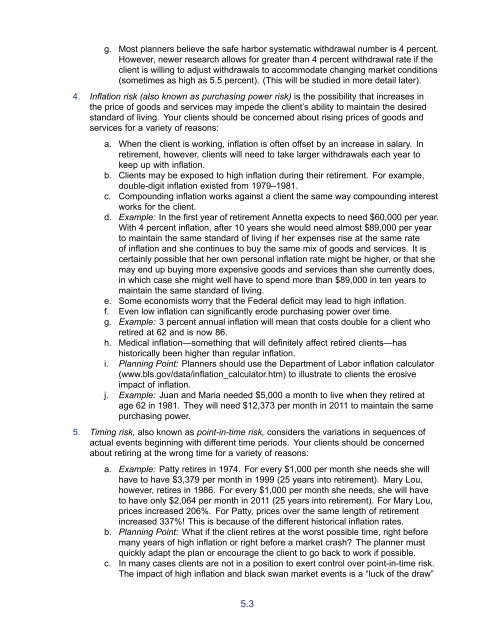section 1 - The American College Online Learning Center
section 1 - The American College Online Learning Center
section 1 - The American College Online Learning Center
You also want an ePaper? Increase the reach of your titles
YUMPU automatically turns print PDFs into web optimized ePapers that Google loves.
g. Most planners believe the safe harbor systematic withdrawal number is 4 percent.However, newer research allows for greater than 4 percent withdrawal rate if theclient is willing to adjust withdrawals to accommodate changing market conditions(sometimes as high as 5.5 percent). (This will be studied in more detail later).4. Inflation risk (also known as purchasing power risk) is the possibility that increases inthe price of goods and services may impede the client’s ability to maintain the desiredstandard of living. Your clients should be concerned about rising prices of goods andservices for a variety of reasons:a. When the client is working, inflation is often offset by an increase in salary. Inretirement, however, clients will need to take larger withdrawals each year tokeep up with inflation.b. Clients may be exposed to high inflation during their retirement. For example,double-digit inflation existed from 1979–1981.c. Compounding inflation works against a client the same way compounding interestworks for the client.d. Example: In the first year of retirement Annetta expects to need $60,000 per year.With 4 percent inflation, after 10 years she would need almost $89,000 per yearto maintain the same standard of living if her expenses rise at the same rateof inflation and she continues to buy the same mix of goods and services. It iscertainly possible that her own personal inflation rate might be higher, or that shemay end up buying more expensive goods and services than she currently does,in which case she might well have to spend more than $89,000 in ten years tomaintain the same standard of living.e. Some economists worry that the Federal deficit may lead to high inflation.f. Even low inflation can significantly erode purchasing power over time.g. Example: 3 percent annual inflation will mean that costs double for a client whoretired at 62 and is now 86.h. Medical inflation—something that will definitely affect retired clients—hashistorically been higher than regular inflation.i. Planning Point: Planners should use the Department of Labor inflation calculator(www.bls.gov/data/inflation_calculator.htm) to illustrate to clients the erosiveimpact of inflation.j. Example: Juan and Maria needed $5,000 a month to live when they retired atage 62 in 1981. <strong>The</strong>y will need $12,373 per month in 2011 to maintain the samepurchasing power.5. Timing risk, also known as point-in-time risk, considers the variations in sequences ofactual events beginning with different time periods. Your clients should be concernedabout retiring at the wrong time for a variety of reasons:a. Example: Patty retires in 1974. For every $1,000 per month she needs she willhave to have $3,379 per month in 1999 (25 years into retirement). Mary Lou,however, retires in 1986. For every $1,000 per month she needs, she will haveto have only $2,064 per month in 2011 (25 years into retirement). For Mary Lou,prices increased 206%. For Patty, prices over the same length of retirementincreased 337%! This is because of the different historical inflation rates.b. Planning Point: What if the client retires at the worst possible time, right beforemany years of high inflation or right before a market crash? <strong>The</strong> planner mustquickly adapt the plan or encourage the client to go back to work if possible.c. In many cases clients are not in a position to exert control over point-in-time risk.<strong>The</strong> impact of high inflation and black swan market events is a “luck of the draw”5.3
















